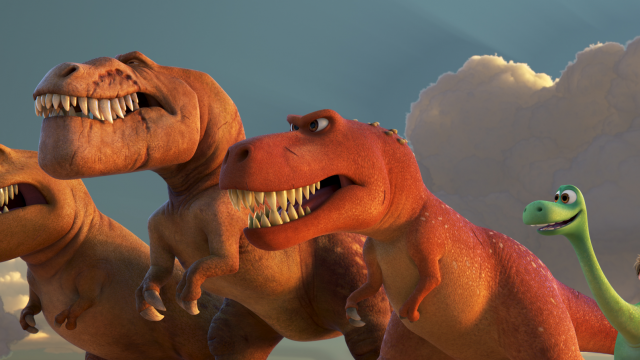One of the reoccurring storytelling templates that have cropped up in the filmography of PIXAR Animation Studios (and it’s such a basic template for storytelling that its reappearance amongst the studios output feels less like repetition and more like an inevitability) is to apply human characteristics to distinctly non-human entities. This trait can even be seen in the pre-PIXAR feature The Brave Little Toaster (incidentally, that’s the movie that inspired my life-long fear of clowns), which employed future PIXAR alumni John Lasseter and Joe Ranft (the latter was a screenwriter on the project) as crucial members of its crew.
Since being part of the group of individuals that brought Lampy and Blankey to the big screen, the various artists at PIXAR have given toys, bugs, fish, monsters, cars, rats, robots and emotions everyday foibles and personalities that audiences can get wrapped up in. That may be the largest problem with The Good Dinosaur, which, as the title implies, has the studio personifying prehistoric critters like T-rexes and raptors. But whereas Finding Nemo had carnivorous sharks attempting to become vegetarians via an AA-style meeting, or Ratatouille had its lead character (a rat) wanting to thrive in the one environment that won’t accept him, very few of the character traits given to the dinosaurs seen in this film directly relate to the everyday characteristics we already associate with these specific kinds of dinos. For instance, one major idea in its plot (which I’ll get to in a moment, don’t worry, this ramble is almost done) is that raptors are now cattle rustlers of sorts. I guess this kind of relates to raptors as predators, but it’s a very loose connection, and there’s very few basic defining characteristics (both in terms of visual cues and personality traits) of cattle rustlers one could put into these raptors. I dunno, it just feels like this aspect of the production is a step down from past similar personification efforts in previous films form the studio.
You might think that such an extensive analysis of this flaw of The Good Dinosaur means that I have numerous critiques to be made of this motion picture, but truth be told, I quite enjoyed this Peter Sohn production. Is it a step down from Up, WALL-E and Toy Story 3? Oh sure. But unlike, say, the hyperactive to a major fault Cars 2, this one seems to recognize its more simplistic narrative and decides to execute its plot more as a straightforward fable than as a more convoluted tale. The story of this one is that Arlo (Raymond Ochoa) is the underdog in his family of Apatosaurus’s (who, as an aside, are all farmers), the smallest of three siblings and constantly afraid of anything and everything.
When he’s swept away from his family by a strong river, Arlo will have to make a treacherous trek back home with the aid of a human boy named Spot (Jack Bright). So yeah, like I said, simple set-up (Arlo is a scaredy-cat, basically), simple premise (road trip to get home), you can probably guess the beats of the plot from there. But that doesn’t mean there isn’t enjoyment to be found in the film, especially since Arlo is well-realized as a character. He’s depicted as a good natured fellow eager to help out his family in their farming activities despite his fearful personality, and that does wonders for making us, the audience, wanting to see him grow as a character during his journey.
Something else that helps this plot work is that it appears that screenwriter Meg LeFauve realized the more simple nature of what she was working with, so instead of attempting to create an overly complex and convoluted narrative for Arlo to inhabit, the film instead tells this story in a very straight-forward sincere manner reminiscent of similarly um-embellished Disney features like Dumbo. This approach carries one or two of its own flaws (there are a few instances where lines of dialogue are so overt I expect even the most dim-witted three year old will feel they’re distracting), but it’s actually a very smart decision that allows the characters and some surprisingly emotionally resonant situations to play out as well as they do.
Along their journey home, Arlo and Spot walk across terrain that’s among the most stunning to come out of any animated film. Not since the painted backgrounds of Sleeping Beauty has such visual audacity been brought forth for animated backdrops, and they do their job well in the narrative of providing a sense of menace for Arlo to be terrified of. Concerns from viewers (myself among ’em) that the more stylized dinosaurs wouldn’t gel well with the far more realistic looking territory can rest easy, as I myself found the merging of the two elements to be pretty damn seamless.
And it wouldn’t be a PIXAR movie if your heartstrings weren’t getting pulled, and there’s a couple of scenes of The Good Dinosaur that are excellently paced in terms of achieving peak emotional resonance. Many of these more heartfelt sequences, as well as other portions of the plot that focus on Arlo surviving on his own in the woods, completely eschew dialogue, a bold but smart choice that I felt really gave The Good Dinosaur its own unique atmosphere. If you’re looking for a movie that hits the quality heights of past PIXAR movies like Inside Out, you won’t find that here. Want something that’s damn good in its own right and gives you Sam Elliot as a rancher T-Rex who fought crocodiles? Well then, this might just work for you. I know it sure as hell worked for me.

